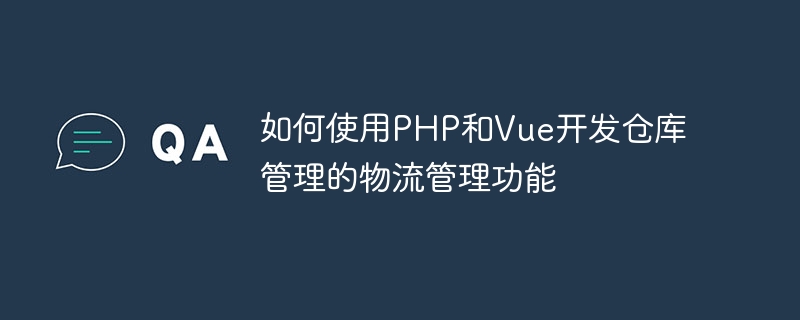PHP と Vue を使用して倉庫管理のための物流管理機能を開発する方法

PHP と Vue を使用して倉庫管理の物流管理機能を開発する方法
電子商取引の急速な発展に伴い、倉庫管理の物流管理機能はますます重要になってきます。この記事では、PHP と Vue を使用してシンプルで実用的な倉庫管理システムを開発する方法と、具体的なコード例を紹介します。
- 環境の準備
開発を開始する前に、開発環境を準備する必要があります。まず、コンピューターに PHP および Vue 開発環境がインストールされていることを確認します。 XAMPP、WAMP、または MAMP をダウンロードしてインストールすることで、ローカルの PHP 開発環境をセットアップできます。同時に、Vue 開発をサポートするために Node.js をインストールする必要もあります。コマンド ラインで次のコマンドを実行すると、Node.js がインストールされているかどうかを確認できます。
node -v
- データベース設計
倉庫管理システムには、保存するデータベースが必要です。物流管理関連データ。この例では、「warehouse」という名前のデータベースを作成し、データを保存するために次の 2 つのテーブルを作成する必要があります。
Item テーブル (アイテム): 倉庫に保管されているすべてのアイテム情報を保存するために使用されます。
CREATE TABLE items ( id INT(11) AUTO_INCREMENT PRIMARY KEY, name VARCHAR(255), quantity INT(11), created_at TIMESTAMP DEFAULT CURRENT_TIMESTAMP );
物流テーブル (出荷): 物流会社、発送者、受取人などを含むすべての物流情報を保存するために使用されます。
CREATE TABLE shipments ( id INT(11) AUTO_INCREMENT PRIMARY KEY, item_id INT(11), company VARCHAR(255), sender VARCHAR(255), receiver VARCHAR(255), created_at TIMESTAMP DEFAULT CURRENT_TIMESTAMP, FOREIGN KEY (item_id) REFERENCES items(id) );
- バックエンド開発 - PHP
次に、PHP を通じてバックエンド API インターフェイスを構築します。
まず、「api」という名前のフォルダーを作成し、その中に「index.php」という名前のファイルを作成します。 「index.php」では、以下のAPIインターフェースを作成します:
すべての商品情報を取得:
<?php
header("Content-Type: application/json");
require_once 'config.php';
$query = "SELECT * FROM items";
$result = mysqli_query($conn, $query);
$items = [];
while ($row = mysqli_fetch_assoc($result)) {
$items[] = $row;
}
echo json_encode($items);新しい商品を作成:
<?php
header('Content-Type: application/json');
require_once 'config.php';
$name = $_POST['name'];
$quantity = $_POST['quantity'];
$query = "INSERT INTO items (name, quantity) VALUES ('$name', $quantity)";
$result = mysqli_query($conn, $query);
$response = [];
if ($result) {
$response['message'] = 'Item created successfully';
} else {
$response['message'] = 'Failed to create item';
}
echo json_encode($response);すべての物流情報を取得:
<?php
header("Content-Type: application/json");
require_once 'config.php';
$query = "SELECT shipments.id, items.name, shipments.company, shipments.sender, shipments.receiver, shipments.created_at
FROM shipments
INNER JOIN items
ON shipments.item_id = items.id";
$result = mysqli_query($conn, $query);
$shipments = [];
while ($row = mysqli_fetch_assoc($result)) {
$shipments[] = $row;
}
echo json_encode($shipments);新しい物流情報を作成します:
<?php
header('Content-Type: application/json');
require_once 'config.php';
$item_id = $_POST['item_id'];
$company = $_POST['company'];
$sender = $_POST['sender'];
$receiver = $_POST['receiver'];
$query = "INSERT INTO shipments (item_id, company, sender, receiver) VALUES ($item_id, '$company', '$sender', '$receiver')";
$result = mysqli_query($conn, $query);
$response = [];
if ($result) {
$response['message'] = 'Shipment created successfully';
} else {
$response['message'] = 'Failed to create shipment';
}
echo json_encode($response);また、「api」フォルダーに「config.php」という名前のファイルを作成する必要があります。これは、データベース接続情報の構成に使用されます:
<?php
$conn = mysqli_connect('localhost', 'root', '', 'warehouse');
if (!$conn) {
die("Connection failed: " . mysqli_connect_error());
}- フロントエンド開発 - Vue
次に、Vue を使用してフロントエンド インターフェイスを開発します。
プロジェクトのルート ディレクトリに「frontend」という名前のフォルダーを作成し、コマンド ラインからそのフォルダーに入ります。
まず、Vue CLI をインストールします。コマンド ラインで次のコマンドを実行します:
npm install -g @vue/cli
新しい Vue プロジェクトを作成します。コマンド ラインで次のコマンドを実行し、プロンプトに従って設定します。
vue create warehouse-management
新しく作成した Vue プロジェクトのディレクトリを入力します。コマンド ラインで次のコマンドを実行します:
cd warehouse-management
必要な依存関係をインストールします。コマンド ラインで次のコマンドを実行します。
npm install
「src」フォルダーに「components」という名前のフォルダーを作成し、その中に次のコンポーネントを作成します。
Item list Component (ItemList.vue) ):
<template>
<div>
<h2 id="物品列表">物品列表</h2>
<table>
<thead>
<tr>
<th>物品名称</th>
<th>数量</th>
<th>操作</th>
</tr>
</thead>
<tbody>
<tr v-for="item in items" :key="item.id">
<td>{{ item.name }}</td>
<td>{{ item.quantity }}</td>
<td>
<button @click="deleteItem(item.id)">删除</button>
</td>
</tr>
</tbody>
</table>
<h3 id="添加新物品">添加新物品</h3>
<input type="text" v-model="newItemName" placeholder="物品名称">
<input type="number" v-model="newItemQuantity" placeholder="数量">
<button @click="createItem">添加</button>
</div>
</template>
<script>
export default {
data() {
return {
items: [],
newItemName: '',
newItemQuantity: 0
};
},
mounted() {
this.getItems();
},
methods: {
getItems() {
axios.get('/api/get_items.php').then(response => {
this.items = response.data;
});
},
createItem() {
axios.post('/api/create_item.php', {
name: this.newItemName,
quantity: this.newItemQuantity
}).then(response => {
this.getItems();
this.newItemName = '';
this.newItemQuantity = 0;
});
},
deleteItem(id) {
axios.post('/api/delete_item.php', {
id: id
}).then(response => {
this.getItems();
});
}
}
};
</script>出荷リスト コンポーネント (paymentList.vue):
<template>
<div>
<h2 id="物流列表">物流列表</h2>
<table>
<thead>
<tr>
<th>物品名称</th>
<th>物流公司</th>
<th>寄件人</th>
<th>收件人</th>
<th>创建时间</th>
</tr>
</thead>
<tbody>
<tr v-for="shipment in shipments" :key="shipment.id">
<td>{{ shipment.name }}</td>
<td>{{ shipment.company }}</td>
<td>{{ shipment.sender }}</td>
<td>{{ shipment.receiver }}</td>
<td>{{ shipment.created_at }}</td>
</tr>
</tbody>
</table>
<h3 id="添加新物流">添加新物流</h3>
<select v-model="selectedItem">
<option v-for="item in items" :value="item.id">{{ item.name }}</option>
</select>
<input type="text" v-model="newShipmentCompany" placeholder="物流公司">
<input type="text" v-model="newShipmentSender" placeholder="寄件人">
<input type="text" v-model="newShipmentReceiver" placeholder="收件人">
<button @click="createShipment">添加</button>
</div>
</template>
<script>
export default {
data() {
return {
items: [],
selectedItem: '',
shipments: [],
newShipmentCompany: '',
newShipmentSender: '',
newShipmentReceiver: ''
};
},
mounted() {
this.getItems();
this.getShipments();
},
methods: {
getItems() {
axios.get('/api/get_items.php').then(response => {
this.items = response.data;
});
},
getShipments() {
axios.get('/api/get_shipments.php').then(response => {
this.shipments = response.data;
});
},
createShipment() {
axios.post('/api/create_shipment.php', {
item_id: this.selectedItem,
company: this.newShipmentCompany,
sender: this.newShipmentSender,
receiver: this.newShipmentReceiver
}).then(response => {
this.getShipments();
this.newShipmentCompany = '';
this.newShipmentSender = '';
this.newShipmentReceiver = '';
});
}
}
};
</script>「src」フォルダー内の「App.vue」ファイルを開き、ファイルの対応する場所に次のコードを追加します。 :
<template>
<div id="app">
<item-list></item-list>
<shipment-list></shipment-list>
</div>
</template>
<script>
import ItemList from './components/ItemList.vue';
import ShipmentList from './components/ShipmentList.vue';
export default {
components: {
ItemList,
ShipmentList
}
};
</script>ここまでで、PHPとVueを使って倉庫管理の物流管理機能を開発するサンプルコードが完成しました。 「npm runserve」コマンドを実行してフロントエンド開発サーバーを起動し、ブラウザで「http://localhost:8080」にアクセスしてプロジェクトの効果を確認できます。同時に、API インターフェイスを有効にするために PHP 開発サーバーを実行する必要もあります。
上記の例が、PHP と Vue を使用して倉庫管理のための物流管理機能を開発する方法を理解するのに役立つことを願っています。もちろん、これは単なる例であり、実際のニーズに応じて機能を拡張および最適化できます。あなたの発展に幸あれ!
以上がPHP と Vue を使用して倉庫管理のための物流管理機能を開発する方法の詳細内容です。詳細については、PHP 中国語 Web サイトの他の関連記事を参照してください。

ホットAIツール

Undresser.AI Undress
リアルなヌード写真を作成する AI 搭載アプリ

AI Clothes Remover
写真から衣服を削除するオンライン AI ツール。

Undress AI Tool
脱衣画像を無料で

Clothoff.io
AI衣類リムーバー

AI Hentai Generator
AIヘンタイを無料で生成します。

人気の記事

ホットツール

メモ帳++7.3.1
使いやすく無料のコードエディター

SublimeText3 中国語版
中国語版、とても使いやすい

ゼンドスタジオ 13.0.1
強力な PHP 統合開発環境

ドリームウィーバー CS6
ビジュアル Web 開発ツール

SublimeText3 Mac版
神レベルのコード編集ソフト(SublimeText3)

ホットトピック
 7489
7489
 15
15
 1377
1377
 52
52
 77
77
 11
11
 19
19
 41
41
 どのようにしてクラスが拡張されたり、PHPでメソッドがオーバーライドされたりするのを防ぐことができますか? (最終キーワード)
Apr 08, 2025 am 12:03 AM
どのようにしてクラスが拡張されたり、PHPでメソッドがオーバーライドされたりするのを防ぐことができますか? (最終キーワード)
Apr 08, 2025 am 12:03 AM
PHPでは、最終的なキーワードを使用して、クラスが継承されないようにし、メソッドが上書きされます。 1)クラスを決勝としてマークする場合、クラスを継承することはできません。 2)メソッドを最終的にマークする場合、メソッドはサブクラスによって書き換えられません。最終的なキーワードを使用すると、コードの安定性とセキュリティが保証されます。
 VUEのボタンに関数を追加する方法
Apr 08, 2025 am 08:51 AM
VUEのボタンに関数を追加する方法
Apr 08, 2025 am 08:51 AM
HTMLテンプレートのボタンをメソッドにバインドすることにより、VUEボタンに関数を追加できます。 VUEインスタンスでメソッドを定義し、関数ロジックを書き込みます。
 VUEトラバーサルの使用方法
Apr 07, 2025 pm 11:48 PM
VUEトラバーサルの使用方法
Apr 07, 2025 pm 11:48 PM
Vue.jsには配列とオブジェクトを通過するには3つの一般的な方法があります。V-Forディレクティブは、各要素をトラバースしてテンプレートをレンダリングするために使用されます。 V-BindディレクティブをV-Forで使用して、各要素の属性値を動的に設定できます。 .mapメソッドは、配列要素を新しい配列に変換できます。
 怠zyなロードVUEとはどういう意味ですか?
Apr 07, 2025 pm 11:54 PM
怠zyなロードVUEとはどういう意味ですか?
Apr 07, 2025 pm 11:54 PM
Vue.jsでは、Lazy Loadingを使用すると、コンポーネントまたはリソースを必要に応じて動的にロードすることができ、初期ページの読み込み時間を短縮し、パフォーマンスを改善できます。特定の実装方法には、&lt; Keep-Alive&gt;および&lt;コンポーネントは&gt;コンポーネント。怠zyなロードは、FOUC(スプラッシュ画面)の問題を引き起こす可能性があり、不必要なパフォーマンスのオーバーヘッドを避けるために怠zyなロードが必要なコンポーネントにのみ使用する必要があることに注意してください。
 Function Intercept Vueの使用方法
Apr 08, 2025 am 06:51 AM
Function Intercept Vueの使用方法
Apr 08, 2025 am 06:51 AM
VUEの関数傍受は、指定された期間内に関数が呼び出され、パフォーマンスの問題を防ぐ回数を制限するために使用される手法です。実装方法は次のとおりです。LodashLibrary:Import {Debounce}から「Lodash」からインポート。 debounce関数を使用して、インターセプト関数を作成します。インターセプト関数を呼び出すと、制御関数は500ミリ秒でせいぜい1回呼び出されます。
 Vue Paginationの使用方法
Apr 08, 2025 am 06:45 AM
Vue Paginationの使用方法
Apr 08, 2025 am 06:45 AM
ページネーションは、パフォーマンスとユーザーエクスペリエンスを向上させるために、大きなデータセットを小さなページに分割するテクノロジーです。 VUEでは、次の組み込みメソッドを使用してページを使用できます。ページの総数を計算します。TotalPages()トラバーサルページ番号:V-For Directive on Currentページを設定します。
 Vue Multi-Page開発とはどういう意味ですか?
Apr 07, 2025 pm 11:57 PM
Vue Multi-Page開発とはどういう意味ですか?
Apr 07, 2025 pm 11:57 PM
VUEマルチページ開発は、VUE.JSフレームワークを使用してアプリケーションを構築する方法です。アプリケーションは別々のページに分割されます。コードメンテナンス:アプリケーションを複数のページに分割すると、コードの管理とメンテナンスが容易になります。モジュール性:各ページは、簡単に再利用および交換するための別のモジュールとして使用できます。簡単なルーティング:ページ間のナビゲーションは、単純なルーティング構成を介して管理できます。 SEOの最適化:各ページには独自のURLがあり、SEOに役立ちます。
 Vueでリーチループを使用する方法
Apr 08, 2025 am 06:33 AM
Vueでリーチループを使用する方法
Apr 08, 2025 am 06:33 AM
vue.jsのforeachループは、v-forディレクティブを使用します。これにより、開発者は各要素を配列またはオブジェクトの各要素を繰り返し、各要素で特定の操作を実行できます。構文は次のとおりです。&lt; Template&gt; &lt; ul&gt; &lt; li v-for =&quot;アイテムの項目&gt;&gt; {{item}}&lt;/li&gt; &lt;/ul&gt; &lt;/template&gt;&am




